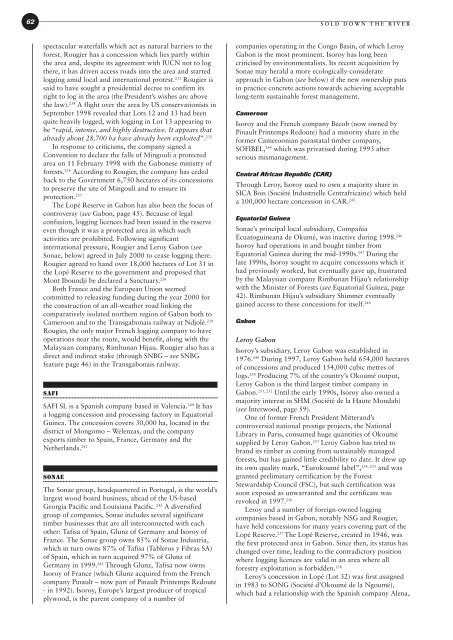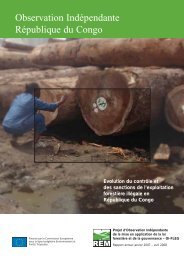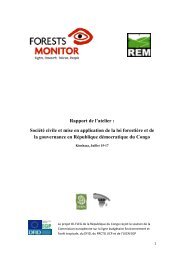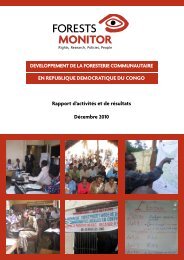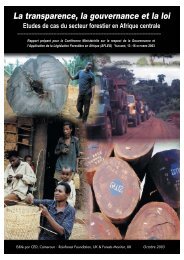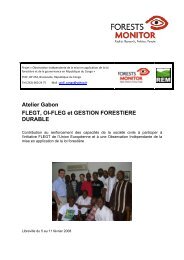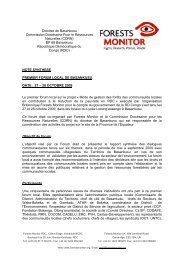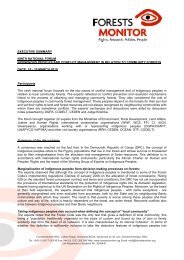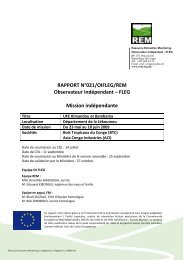Sold down the river - Salva le Foreste
Sold down the river - Salva le Foreste
Sold down the river - Salva le Foreste
Create successful ePaper yourself
Turn your PDF publications into a flip-book with our unique Google optimized e-Paper software.
62SOLD DOWN THE RIVERspectacular waterfalls which act as natural barriers to <strong>the</strong>forest. Rougier has a concession which lies partly within<strong>the</strong> area and, despite its agreement with IUCN not to log<strong>the</strong>re, it has driven access roads into <strong>the</strong> area and startedlogging amid local and international protest. 233 Rougier issaid to have sought a presidential decree to confirm itsright to log in <strong>the</strong> area (<strong>the</strong> President’s wishes are above<strong>the</strong> law). 234 A flight over <strong>the</strong> area by US conservationists inSeptember 1998 revea<strong>le</strong>d that Lots 12 and 13 had beenquite heavily logged, with logging in Lot 13 appearing tobe “rapid, intense, and highly destructive. It appears thatalready about 28,700 ha have already been exploited”. 235In response to criticisms, <strong>the</strong> company signed aConvention to declare <strong>the</strong> falls of Mingouli a protectedarea on 11 February 1998 with <strong>the</strong> Gabonese ministry offorests. 236 According to Rougier, <strong>the</strong> company has cededback to <strong>the</strong> Government 6,750 hectares of its concessionsto preserve <strong>the</strong> site of Mingouli and to ensure itsprotection. 237The Lopé Reserve in Gabon has also been <strong>the</strong> focus ofcontroversy (see Gabon, page 45). Because of <strong>le</strong>galconfusion, logging licences had been issued in <strong>the</strong> reserveeven though it was a protected area in which suchactivities are prohibited. Following significantinternational pressure, Rougier and Leroy Gabon (seeSonae, below) agreed in July 2000 to cease logging <strong>the</strong>re.Rougier agreed to hand over 18,000 hectares of Lot 31 in<strong>the</strong> Lopé Reserve to <strong>the</strong> government and proposed thatMont Iboundji be declared a Sanctuary. 238Both France and <strong>the</strong> European Union seemedcommitted to re<strong>le</strong>asing funding during <strong>the</strong> year 2000 for<strong>the</strong> construction of an all-wea<strong>the</strong>r road linking <strong>the</strong>comparatively isolated nor<strong>the</strong>rn region of Gabon both toCameroon and to <strong>the</strong> Transgabonais railway at Ndjolé. 239Rougier, <strong>the</strong> only major French logging company to haveoperations near <strong>the</strong> route, would benefit, along with <strong>the</strong>Malaysian company, Rimbunan Hijau. Rougier also has adirect and indirect stake (through SNBG – see SNBGfeature page 46) in <strong>the</strong> Transgabonais railway.SAFISAFI SL is a Spanish company based in Va<strong>le</strong>ncia. 240 It hasa logging concession and processing factory in EquatorialGuinea. The concession covers 30,000 ha, located in <strong>the</strong>district of Mongomo – We<strong>le</strong>nzas, and <strong>the</strong> companyexports timber to Spain, France, Germany and <strong>the</strong>Ne<strong>the</strong>rlands. 241SONAEThe Sonae group, headquartered in Portugal, is <strong>the</strong> world’slargest wood board business, ahead of <strong>the</strong> US-basedGeorgia Pacific and Louisiana Pacific. 242 A diversifiedgroup of companies, Sonae includes several significanttimber businesses that are all interconnected with eacho<strong>the</strong>r: Tafisa of Spain, Glunz of Germany and Isoroy ofFrance. The Sonae group owns 85% of Sonae Industria,which in turn owns 87% of Tafisa (Tab<strong>le</strong>ros y Fibras SA)of Spain, which in turn acquired 97% of Glunz ofGermany in 1999. 243 Through Glunz, Tafisa now ownsIsoroy of France (which Glunz acquired from <strong>the</strong> Frenchcompany Pinault – now part of Pinault Printemps Redoute- in 1992). Isoroy, Europe’s largest producer of tropicalplywood, is <strong>the</strong> parent company of a number ofcompanies operating in <strong>the</strong> Congo Basin, of which LeroyGabon is <strong>the</strong> most prominent. Isoroy has long beencriticised by environmentalists. Its recent acquisition bySonae may herald a more ecologically-considerateapproach in Gabon (see below) if <strong>the</strong> new ownership putsin practice concrete actions towards achieving acceptab<strong>le</strong>long-term sustainab<strong>le</strong> forest management.CameroonIsoroy and <strong>the</strong> French company Becob (now owned byPinault Printemps Redoute) had a minority share in <strong>the</strong>former Cameroonian parastatal timber company,SOFIBEL, 244 which was privatised during 1993 afterserious mismanagement.Central African Republic (CAR)Through Leroy, Isoroy used to own a majority share inSICA Bois (Société Industriel<strong>le</strong> Centrafricaine) which helda 100,000 hectare concession in CAR. 245Equatorial GuineaSonae’s principal local subsidiary, CompañiaEcuatoguineana de Okumé, was inactive during 1998. 246Isoroy had operations in and bought timber fromEquatorial Guinea during <strong>the</strong> mid-1990s. 247 During <strong>the</strong>late 1990s, Isoroy sought to acquire concessions which ithad previously worked, but eventually gave up, frustratedby <strong>the</strong> Malaysian company Rimbunan Hijau’s relationshipwith <strong>the</strong> Minister of Forests (see Equatorial Guinea, page42). Rimbunan Hijau’s subsidiary Shimmer eventuallygained access to <strong>the</strong>se concessions for itself. 248GabonLeroy GabonIsoroy’s subsidiary, Leroy Gabon was established in1976. 249 During 1997, Leroy Gabon held 654,000 hectaresof concessions and produced 154,000 cubic metres oflogs. 250 Producing 7% of <strong>the</strong> country’s Okoumé output,Leroy Gabon is <strong>the</strong> third largest timber company inGabon. 251, 252 Until <strong>the</strong> early 1990s, Isoroy also owned amajority interest in SHM (Société de la Haute Mondah)(see Interwood, page 59).One of former French President Mitterand’scontroversial national prestige projects, <strong>the</strong> NationalLibrary in Paris, consumed huge quantities of Okoumésupplied by Leroy Gabon. 253 Leroy Gabon has tried tobrand its timber as coming from sustainably managedforests, but has gained litt<strong>le</strong> credibility to date. It drew upits own quality mark, “Eurokoumé label”, 254, 255 and wasgranted preliminary certification by <strong>the</strong> ForestStewardship Council (FSC), but such certification wassoon exposed as unwarranted and <strong>the</strong> certificate wasrevoked in 1997. 256Leroy and a number of foreign-owned loggingcompanies based in Gabon, notably NSG and Rougier,have held concessions for many years covering part of <strong>the</strong>Lopé Reserve. 257 The Lopé Reserve, created in 1946, was<strong>the</strong> first protected area in Gabon. Since <strong>the</strong>n, its status haschanged over time, <strong>le</strong>ading to <strong>the</strong> contradictory positionwhere logging licences are valid in an area where allforestry exploitation is forbidden. 258Leroy’s concession in Lopé (Lot 32) was first assignedin 1983 to SONG (Société d’Okoumé de la Ngoumé),which had a relationship with <strong>the</strong> Spanish company A<strong>le</strong>na,


